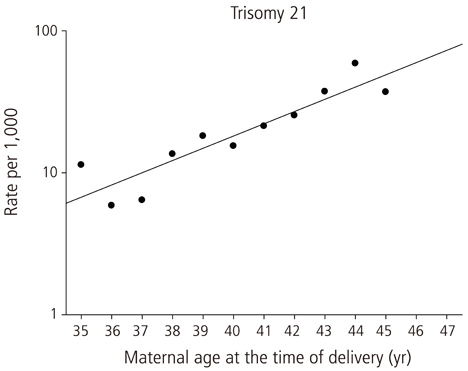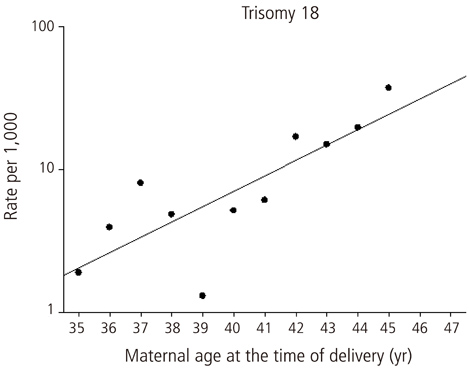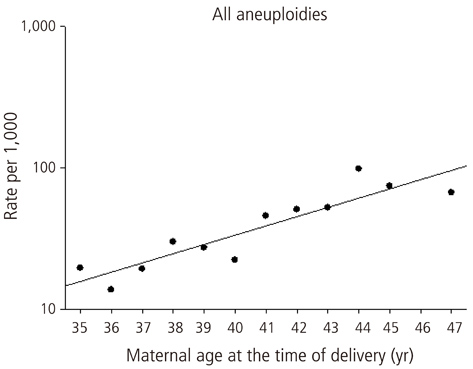Obstet Gynecol Sci.
2013 May;56(3):160-166.
Maternal age-specific rates of fetal chromosomal abnormalities in Korean pregnant women of advanced maternal age
- Affiliations
-
- 1Department of Obstetrics and Gynecology, CHA Gangnam Medical Center, CHA University, Seoul, Korea. sarah13@hanmail.net
Abstract
OBJECTIVE
To evaluate the association of maternal age with occurrence of fetal chromosomal abnormalities in Korean pregnant women of advanced maternal age (AMA).
METHODS
A retrospective review of the amniocentesis or chorionic villous sampling (CVS) database at Gangnam and Bundang CHA Medical Centers, between January 2001 and February 2012, was conducted. This study analyzed the incidence of fetal chromosomal abnormalities according to maternal age and the correlation between maternal age and fetal chromosomal abnormalities in Korean pregnant women > or =35 years of age. In addition, we compared the prevalence of fetal chromosomal abnormalities between women of AMA only and the others as the indication for amniocentesis or CVS.
RESULTS
A total of 15,381 pregnant women were selected for this study. The incidence of aneuploidies increased exponentially with maternal age (P<0.0001). In particular, the risk of trisomy 21 (standard error [SE], 0.0378; odds ratio, 1.177; P<0.001) and trisomy 18 (SE, 0.0583; odds ratio, 1.182; P=0.0040) showed significant correlation with maternal age. Comparison between women of AMA only and the others as the indication for amniocentesis or CVS showed a significantly lower rate of fetal chromosomal abnormalities only in the AMA group, compared with the others (P<0.0001).
CONCLUSION
This study demonstrates that AMA is no longer used as a threshold for determination of who is offered prenatal diagnosis, but is a common risk factor for fetal chromosomal abnormalities.
MeSH Terms
Figure
Reference
-
1. Kwon JY, Park IY, Kwon SM, Kim CJ, Shin JC. The quadruple test for Down syndrome screening in pregnant women of advanced maternal age. Arch Gynecol Obstet. 2012. 285:629–633.2. Dailey T, Dale B, Cohen J, Munne S. Association between nondisjunction and maternal age in meiosis-II human oocytes. Am J Hum Genet. 1996. 59:176–184.3. Freeman SB, Allen EG, Oxford-Wright CL, Tinker SW, Druschel C, Hobbs CA, et al. The National Down Syndrome Project: design and implementation. Public Health Rep. 2007. 122:62–72.4. Hassold T, Abruzzo M, Adkins K, Griffin D, Merrill M, Millie E, et al. Human aneuploidy: incidence, origin, and etiology. Environ Mol Mutagen. 1996. 28:167–175.5. Ferguson-Smith MA, Yates JR. Maternal age specific rates for chromosome aberrations and factors influencing them: report of a collaborative european study on 52 965 amniocenteses. Prenat Diagn. 1984. 4:5–44.6. Park IY, Kwon JY, Kim YH, Kim M, Shin JC. Maternal age-specific rates of fetal chromosomal abnormalities at 16-20 weeks' gestation in Korean pregnant women >or=35 years of age. Fetal Diagn Ther. 2010. 27:214–221.7. Han SH, An JW, Yang YH, Kim YJ, Cho HI, Lee KR. Incidence and spectrum of chromosomal abnormalities associated with spontaneous abortions in Korea: 470 products of conception over a period of 6 years (2005-2010). J Genet Med. 2011. 8:44–52.8. Malone FD, Canick JA, Ball RH, Nyberg DA, Comstock CH, Bukowski R, et al. First-trimester or second-trimester screening, or both, for Down's syndrome. N Engl J Med. 2005. 353:2001–2011.9. ACOG Committee on Practice Bulletins. ACOG Practice Bulletin No. 77: screening for fetal chromosomal abnormalities. Obstet Gynecol. 2007. 109:217–227.10. Driscoll DA, Morgan MA, Schulkin J. Screening for Down syndrome: changing practice of obstetricians. Am J Obstet Gynecol. 2009. 200:459.e1–459.e9.11. Bornstein E, Lenchner E, Donnenfeld A, Barnhard Y, Seubert D, Divon MY. Advanced maternal age as a sole indication for genetic amniocentesis; risk-benefit analysis based on a large database reflecting the current common practice. J Perinat Med. 2009. 37:99–102.12. Henry GP, Britt DW, Evans MI. Screening advances and diagnostic choice: the problem of residual risk. Fetal Diagn Ther. 2008. 23:308–315.
- Full Text Links
- Actions
-
Cited
- CITED
-
- Close
- Share
- Similar articles
-
- Triple marker screening for fetal chromosomal abnormalities in Korean women of advanced maternal age
- Maternal-Fetal Interaction Belief and Maternal-Fetal Interaction
- Relationship Between Maternal Fetal Attachment and State Anxiety of Pregnant Women in the Preterm Labor
- Observed frequency of fetal trisomy between 16 and 24 gestational weeks in pregnant women older than 34 years at delivery
- Amniotic Chromosomal Analysis in Pregnant Women Identified by Triple-Marker Testing as Screen Positive





